#free rapa nui
Text
welcome!
this blog loves planet earth and the people in it.
some notes:
I generally try to identify places + groups
I try to make conscious decisions about tags that respect cultural identities, consider historical context and reject imperialism. I realize this is impossible and messy and doomed to be inconsistent. choices I've made include one Korea, one Ireland, and multiple tags for separatist states, i.e. Scotland, Catalan Countries.
I am currently unsure when or if it makes sense to tag the "bigger" nation in a post about an autonomous region, ex. China and Tibet, Faroe Islands and Denmark. I want to respect widespread independence movements, but also not become bloated with regional tags. Tibet deserves to be free of China but I have to laugh at modern Texas separatism.
Israel does not get a tag. Jewish diaspora, Free Palestine, genocide, USA, and anti imperialism are used.
I am not always sure when to use the indigenous peoples tag. if I am unsure I will probably leave it out.
except the history and prehistory tag, I currently am not tagging things that no longer exist, ex. Soviet Union, Ancient Greece
Some tags like EU, UK, Africa, Asia, Latin American, Polynesian, etc. are used in posts that refer to many places/groups collectively ex. Lunar New Year in Asia
I try to tag the country/group that an artist/writer/creator belongs to, ex. a post featuring Baldwin tagged with USA, literature, black diaspora
tags are ever-evolving
country/place tags:
Africa, Albania, Argentina, Armenia, Asia, Australia, Austria, Azerbaijan, Belarus, Belgium, Bhutan, Bosnia and Herzegovina, Botswana, Brazil, Bulgaria, Cameroon, Canada, Catalan Countries, Central African Republic, Chad, Chile, China, Colombia, Congo, Cuba, Czechia, Denmark, Dominican Republic, Emirates, Estonia, Ethiopia, EU, Faroe Islands, Finland, France, Germany, Greece, Greenland, Guatemala, Haiti, Hawai'i, Hungary, Iceland, India, Iran, Ireland, Italy, Japan, Kazakhstan, Kenya, Korea, Kosovo, Kyrgyzstan, Latvia, Lithuania, Malaysia, Maldives, Mexico, Moldova, Mongolia, Montenegro, Mozambique, Namibia, New Zealand, Niger, Nigeria, North Macedonia, Norway, Pakistan, free Palestine, Panama, Paraguay, Peru, Philippines, Portugal, Puerto Rico, Qatar, Romania, Russia, Scotland, Serbia, Slovakia, Slovenia, Somalia, South Africa, South Sudan, Spain, Sri Lanka, Sudan, Sweden, Switzerland, Syria, Taiwan, Tajikistan, Tanzania, Thailand, free Tibet, Turkey, Uganda, Ukraine, USA, Uzbekistan, Vietnam, West Papau, Yemen, Zambia, Zimbabwe
diaspora + ethnic group + cultural group tags:
Ainu, Apache, Bahá'í, Basque, Black diaspora, Chechen, Choctaw, Chulym, Dakota, Dolgan, Galician, Gavião, Guarani-Kaiowá, Hui, Igbo, immigrants, Inuit, Ixil, Jewish diaspora, Karakalpak, Kashmir, Kazakh, Ket, Khakas, Lakota, Latin American, Lezgin, Mah Meri, Maka, Makonda, Mohegan, Ojibwe, Pataxo, Polynesian, Q'eqchi', Rapa Nui, Rohingya, Romani, Rukai, Ryukyuan, Sakapultek, Samburu, Sámi, Selkup, Sioux, Tamil, Tatar, Tigray, Tlingit, Tokalau, Uyghur, Yazidi
culture + other tags:
agriculture, airports, animals and wildlife, architecture, art, children, clothing and textiles, dance, ecology and environmentalism, festivals and holidays, film and tv, food, geopolitics, history, infrastructure, language, literature, maps, music, myth and legend, my posts, nature, prehistory, postcards and stamps, public transportation, religions and belief systems, solidarity, sports and games, traditions and customs, true spirit of the blog, urban landscape, water and boats
ugly tags:
acab, anti capitalism, anti imperialism, anti misogyny, anti xenophobia, genocide
0 notes
Text
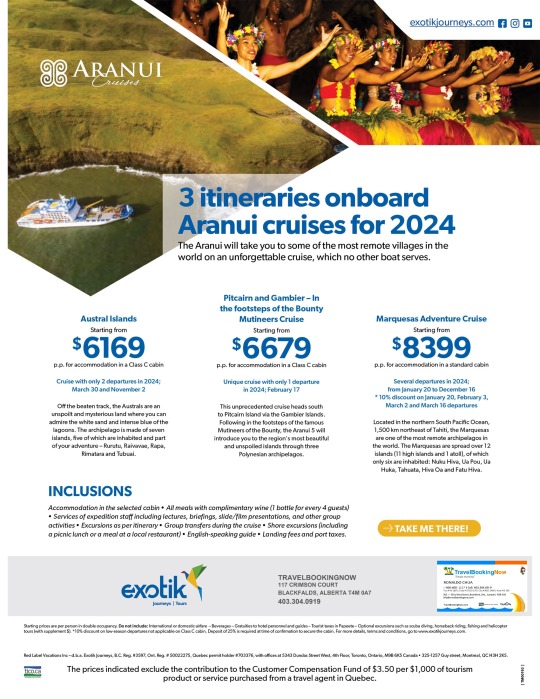
#travelbookingnow
Sail into History: Explore the Mysteries of Rapa Nui and Beyond! Join Aranui Cruises on a captivating expedition to the legendary Easter Island and the unspoiled beauty of the Chilean islands in 2024. Marvel at the iconic moai statues, witness fascinating archaeological sites, and dive into the clear waters teeming with marine life. Indulge in authentic experiences and let the stories of ancient civilizations come to life on this extraordinary voyage to the Pacific's most intriguing destinations.
1 note
·
View note
Note
hi! just a little tip, from a chilean. you mention in one of your pages that you can have "a manjar" for lunch, but while you can literally translate "manjar" as a general delicacy, the term "manjar" most often refers to a sweet spread that we most often put on bread. so, you'd most likely have it at breakfast or for tea (té/once)! (1/2)
(2/2) more importantly: rapa nui is nowhere near valparaíso, and i'm actually surprised (and tbh kinda disappointed) that it's included here? rapa nui is an island in the south. and the museum of fine arts, by which i think you mean the bellas artes, is in santiago – not vaparaíso. / chilean anon here - last note! i believe that the photo you used for the u of valparaíso is not of that university, but rather of pontificia universidad católitca de vaparaíso (pucv), which is a different university entirely
Hello ! Thanks so much for reaching out and sharing your concerns ! We definitely appreciate feedback like this as the last thing we want to do is be insensitive to a country we're not native to ! The small things first, the portion that mentions the "manjar" was more a reference to the menu being a rolling menu, so no matter the time of day, you'd be able to order it if you wanted to ! But I think finding a breakfast dish would more accurately reflect that sentiment.
Sincerest apologies about the addition of Rapa Nui. I was primarily using trip planning sites to find a variety of locations within the city and a lot of them listed Rapa Nui, and I should have double checked with google maps to ensure that it was in fact located in Valparaíso. A complete oversight on my part and I apologize. We will be changing that location to La Campana National Park.
Lastly, we wanted to set the rp in a location that isn’t normally seen in the rpc. We thought Valparaíso was a beautiful place to do that, though we are not natives nor have ever been there. We really appreciate your feedback because we want to be respectful of the city and the country. We also want to be realistic with how much information we can provide for our members and how much they can find that’s accurate, so in order to maintain respect to the real places within Chile, we’ll be adjusting the university to be fictional and will also swap the National Fine Arts Museum with the National History Museum (google maps says its located in Valparaíso but if this is wrong we can change it of course ! ). We apologize for using the incorrect picture for the University ! The name and picture were both primarily used as inspiration for a fictional university, but we recognize why that was so confusing so we will be altering the name to one that doesn’t reflect a real place and use the image solely as visual inspo.
As we make the necessary changes, we’ll also be putting a disclaimer in our pinned and on our main to hopefully alleviate misunderstandings. Thank you again for providing feedback! We will fix things shortly! If you or anyone else have further questions or concerns, please feel free to reach back out !
0 notes
Text
Каждую неделю рыбаки вытаскивают кусочки Lego у берегов Корнуолла, спустя более 25 лет после потопа огромного грузового судна с детскими игрушками Лего.
Более пяти миллионов деталей Lego были потеряны Tokio Express у Лендс-Энда в 1997 году, когда волна сбросила 62 контейнера в море.
С тех пор детали LEGO появляются на берегу моря вдоль пляжей Корнуолла, детали были найдены на Нормандских островах, в Ирландии, Голландии и Дании.
История рассказывается на выставке в Королевском музее Корнуолла.
Lego Group заявила, что разлив был «несчастным случаем».
Детали Lego, потерянные в море, включают в себя:
352 000 пар ластов для дайверов
97 500 миниатюрных аквалангистов
88 316 наборов крошечных цветов
54 000 кусочков водорослей
33 941 дракон - 514 были зелеными
26 600 желтых спасательных жилетов для мини-фигурок
26 400 единиц судового такелажа
Проект г-жи Уильямс Lego Lost at Sea был удостоен награды «Спасательный проект года» на церемонии вручения наград Current Archaeology Awards 2023.
Экспозиция открыта до 23 сентября. Цены на вход:
Дети до 18 лет: Бесплатные
участники: Бесплатно
Взрослые: 7.50 фунтов стерлингов (заплатите один раз, получите бесплатно в течение года)
[caption id="attachment_23073" align="alignleft" width="400"] Летняя выставка: По течению: Лего затерянный в море11 июля – 23 сентября[/caption]
Summer Exhibition: Adrift: Lego Lost at Sea
11 July – 23 September
In 1997, a rogue wave knocked 62 containers from a cargo ship off the coast of Cornwall. Five million pieces of lego were set adrift in the ocean, washing up on beaches across the southwest. Adrift – Lego Lost at Sea is the story of what was lost and what was learned about the ocean, its currents and pollution.
The exhibition has been inspired by author, Tracey Williams whose book, Adrift: the curious tale of the Lego lost at sea shares Tracey’s personal story of beachcombing for Lego as well as other weird and not so wonderful objects washed in from the ocean.
Artist Rob Arnold also features in the exhibition with his awareness raising works such as a sculpture inspired by the Moai statues on Rapa Nui made from plastics collected from Cornish beaches. Read our full blog on this exhibition.
During this exhibition, you can:
Learn more about the plastic that washes up on shore through the words of beachcombers like Tracey Williams
Explore art and collections prompted by plastic pollution
Join events exploring the exhibition’s themes
Take part in ‘Plastic Soup’ – a programme of children’s activities inspired by Adrift
And more!
Entry prices:
Under 18s: Free
Members: Free
Adults: £7.50 (Pay once, get in free for the year)
Новости Великобритании. ONLYWAY.NEWS
0 notes
Note
So I’ve been thinking about the end of empires lately, the way they behave, the patterns that emerge, things like that. Yes, I know. What a lovely topic. Lol. My brain likes punishment. Shhh. Anyway, I was wondering what we have learned from past ended empires that could help us understand today’s world? Do you have thoughts? Any book refs on this? Thanks qqueen!
Aha, okay, I'll give this a crack. I'll try not to get bogged down in too much pedagogical woolgathering about how it is defined, determined, decided, or otherwise applied as an analytical concept, but we'll say that an "empire" is a geographical, political and territorial unit that comprises multiple countries/regions, is united under one relatively centralised administration, ruled either by one all-powerful figure or a small circle of powerful elites (usually technically answerable to the former), and held together by military, financial, and ideological methods. The basic model, as established by the Romans: take their sons to serve in the army, make them pay their taxes to you, and worship Roma, the patron goddess of the city, alongside their own preferred religion. Simple, straightforward, and lasted for five hundred years (almost a thousand if you count the Roman Republic which preceded it). We hear a lot in Western history classes about the "Fall of Rome," which is usually presented in popular narratives as the moment when everything went to pot before the "Dark Ages." Is this true? (No.) If so, did it happen because, as is often claimed, "barbarians/savages were attacking Rome and overthrew it?" (No.)
The collapse of the Western Roman Empire is way more than we can get into in the course of one ask, and there are other fallen empires to consider: for example, the Aztec, Ashanti, Russian, and British ones. It's a subject of debate as to whether modern-day America should be termed an empire: it fits most, if not all, of the historical criteria, but is an empire only an empire when it declares itself to be one? The long and sordid history of American imperialism, whether it's a rose by any other name or otherwise, is covered in American Empire: A Global History by A.G. Hopkins, How to Hide an Empire: A History of the Greater United States by Daniel Immerwahr, and A People's History of American Empire by Howard Zinn. All are worth looking into.
Overall, I think the basic similarities for what makes an empire fall would include:
it geographically overextends itself (Roman, British)
it is attacked by foreign rivals and internal enemies (Roman, Aztec, Ashanti)
it becomes massively financially indebted and deeply politically unstable (Roman, Russian)
it resorts to heavy-handed attempts to punish dissatisfaction among its people, spurring popular resistance (Aztec, Roman, British, Russian)
it is emerging from a period of long war internationally and internally that has strained it militarily (Roman, British, Russian)
it simply gets devastatingly unlucky thanks to a combination of unforeseeable external factors (Aztec, Ashanti)
And so on. Basically, the administrative bureaucracy gets too big to manage itself, the ever-increasing financial exactions can't pay for the necessary wars to maintain and expand its borders, people become dissatisfied both outside and inside the imperial system, and since no human institution or nation-state lasts forever, down it comes. However, I would caution against too much insistence on a total or categorical end of any of these societies. You've probably heard of Jared Diamond, who wrote uber-popular bestsellers including Guns, Germs, and Steel and Collapse, focusing on how human societies survive, or not, from an eco-scientific perspective. However, Diamond is not a trained anthropologist, archaeologist, or historian, despite writing extensively about these subjects (he's a professor of geography at UCLA) and a whole bunch of eminent historians and anthropologists got together to write "You're Full of Shit, Jared Diamond," also known as Questioning Collapse: Human Resilience, Ecological Vulnerability, and the Aftermath of Empire.
This book basically blasts Diamond (as he deserves, frankly) for removing all social/cultural factors from his analysis in Collapse and only focusing on ecology/science/environment. Geographical determinism can shed light on some things, but it's very far from being a total explanation for everything, completely divorced from the human societies that interact with these places. For example, did the Easter Island society of Rapa Nui collapse because the Polynesian people "recklessly" overexploited the environment (Diamond) or the impact of European diseases, colonialism, slave trade, and other direct crises, combined with the introduction of the non-native rat to the islands? (Spoiler alert: The latter. You simply can't write about these societies as if they're just places where things somehow happened thanks to natural processes, entirely outside of human agency and cultural/social/political needs.)
Anyway, the silver-lining upside, especially in an incredibly gloomy political milieu where the current American system was nearly overthrown by the last president and hordes of his fascist sympathisers (as they were talking about on Capitol Hill today, incidentally), is that the usual story of human societies is resilience rather than disappearance. None of the empires listed above, with the exception of the Aztecs (conquered by the Spanish, decimated by smallpox, and resisted by internal indigenous enemies) totally vanished. Their structures and ethos often just got a change of paint and name and carried on. For all the ballyhoo about the "Collapse of Rome," the Western Roman Empire had been an almost entirely ineffective political entity for years and the capital had already been transferred to Ravenna well before 476. There were outsider attacks, but Rome had weakened itself by a constant succession of military coups, palace intrigue, too-heavy taxes, and a simply too-vast area to effectively control. The Eastern Roman Empire, however (aka the Byzantine Empire) carried on being a major political player straight through the medieval period and only ended in 1453, with the Ottoman sultan Mehmed II's conquest of Constantinople.
Even the Ashanti Empire still exists today, as a small independent kingdom within the modern African country of Ghana. The Russian and British empires no longer exist under that name, but few would deny that those countries still retain considerable influence in similar ways. When people talk about the "collapse" of societies, especially non-Western societies, it also produces the impression that they did in fact just disappear into thin air, often as no fault of the invading Westerners. (Sidenote: I suggest reading "Settler Colonialism and the Elimination of the Native" by Patrick Wolfe in the Journal of Genocide Research. The whole thing is online and free.) How many times have we heard that, say, the Mayans/Mayan Empire "vanished," when there are up to seven million Mayan speakers in modern Mexico? If you're insisting that they're gone, of course it's easier to act like they are.
Anyway. I think what I'm trying to say here is that in terms of lessons for the modern world:
empires always (always) fall;
this comes about as some combination of the above-mentioned factors;
however, the societies previously organised as empires almost never disappear, so the end of an empire does not necessarily mean the end of its attendant society, culture, countries, etc;
empires often re-organise as essentially similar political units with different names and can maintain most of their former status;
empire is an inherently unequal and exploitative system that often relies on taxonomies of race, gender, power, and class, with the usual suspects at the top and everyone else at the bottom;
empire is usually, though not always, related to active colonialism and military expansion, and as soon as it cannot sustain this model, it's in big trouble;
the idea that human societies just disappear solely as a result of inadequately correct economic choices and/or ecological determinism is a lot of shit;
And so on. The end of an empire isn't necessarily anything to fear, though it can, obviously, be incredibly disruptive for those living within the country/countries affected. And until we learn how to move, as a species, permanently away from political and ideological systems that give so many resources to so few people and nothing to so many others, we're going to continue to experience this cycle.
34 notes
·
View notes
Text
Western nuclear testing in the Pacific, and in particular the French programme, which stretched across three decades (1966–96), has generated protest movements and literatures that – in keeping with Hauʻofa’s model – transcend imposed colonial divisions in the Pacific by fostering regional solidarity. [...]
Gorodé is a significant figure to consider within this context of transoceanic anti-nuclear protest, as like many Indigenous Pacific women she has been closely involved in the Nuclear Free and Independent Pacific Movement. She was also one of the founders of Groupe 1878 (a Kanak independence movement named after a 19th-century Indigenous uprising against French colonial rule), and when she was jailed in Camp-Est prison (in Noumea) for “disturbing the peace” during a 1974 sit-in at local law courts, she wrote two anti-nuclear poems: “Clapotis” (“Wave Song”) and “Zone Interdite” (“Forbidden Zone”). As the title of “Clapotis” (which could be translated more literally as “the lapping of water”) suggests, imagery of the sea is central to the poem, which begins by contrasting the sere, inhospitable environment of the prison exercise yard with the plentitude and dynamism of the sea beyond the prison walls.
Anticipating Hauʻofa’s model of an interconnected Oceania, Gorodé posits the movement of the waves as conveying ripples of protest from Oceania’s easternmost island, Rapanui, against the violence of the Chilean political regime that holds jurisdiction over “Easter Island”, and subsequently bearing witness to the nuclear violence “infecting the sky” over Moruroa. The wave also holds the potential to “carry” Indigenous Pacific peoples forward in their resistance to imperialism, gathering and imparting radical energies through its transoceanic trajectories [...].
Thus the poem establishes what Édouard Glissant terms a “poetics of relation”, a referential system that, rather than remaining rooted in individual national contexts, engages in a horizontal, transoceanic dialogue with other cultures, languages and value systems in its critique of colonialism (Glissant 1997, 44–46). Glissant’s theory (which takes the Caribbean as its main point of reference) is comparable to Hauʻofa’s in positing the sea as a basis for elaborating a regional, interpelagic identity, and as Elizabeth DeLoughrey has noted, Edward Kamau Brathwaite’s concept of tidalectics (another Caribbean theoretical model) is also a productive paradigm for analysing the “cyclic” ebb and flow of the Pacific, and of the diasporic populations that have moved across and within it [...].
Notably, Gorodé’s “Wave Song” extends its poetics of relation not just to francophone and hispanophone cultures elsewhere in Oceania, but also to the internal politics of Chile in the 1970s, making reference to the deposing of Salvador Allende’s [...] government and the torture and murder of left-wing activists [...]. Chile’s internecine violence, enacted on its own nationals, is shown to be redolent of its colonial conquest of Easter Island/Rapa Nui, and resonates, in a tidalectic pattern of ebb and flow, with the waves of French colonial violence rippling out from New Caledonia, via French Polynesia, towards the easternmost point of Oceania and back again.
-------
In an effort to transcend these [colonial, Euro-American-imposed] divisions, in the 1990s Hauʻofa produced a series of influential essays advocating a new regional “Oceanic” politico-ideological identity that would not only help unite and protect Pacific Islanders against the vicissitudes of global capitalism and climate change (a significant consideration given that Pacific Islanders are among the earliest casualties of rising sea levels, as well as suffering the long-term effects of nuclear imperialism), but could also serve as a source of inspiration to contemporary Pacific artists and creative writers (see Hauʻofa 2008). Hauʻofa’s model acknowledges the complex and interweaving local, regional and global networks that shape the lives of contemporary Pacific peoples [...].
-------
When Algeria gained its independence from France in 1962, France was forced to end its nuclear testing programme in what is now the Algerian Sahara, and chose French Polynesia as its new testing site, establishing facilities on two atolls in the Tuamotu Island group: Fangataufa and Moruroa [...]. As knowledge of the adverse impact of French nuclear testing became more widely publicized in the 1970s, increasing numbers of newly independent Pacific island nations (as well as settler and Indigenous communities in Australia and New Zealand) expressed vigorous opposition to the tests. [...] [I]n the ensuing years the movement intersected with other campaigns against large-scale military manoeuvres, the testing of intercontinental ballistic missiles at Kwajalein in the Marshall Islands, test bombing at Kahoʻolawe Island in Hawaiʻi, the mining of uranium in Australia, and the dumping of radioactive waste in the Pacific by Japan [...].
While such events created severe schisms between the nuclear powers and white settler nations [”New Zealand”] in the Pacific, they also prompted Indigenous Pacific peoples to unite against the nuclear desecration of their homelands, triggering affiliations that transcended the geopolitical and linguistic divides that often hamper creative dialogue between, for example, anglophone and francophone [...] writers. (This has particular significance given that it was the French explorer Dumont d’Urville who devised the tripartite geocultural division between Polynesia, Melanesia and Micronesia that still operates to this day [see Dumont D’Urville 1832].)
Maori artist Ralph Hotere, for example, made a significant gesture of solidarity with French Polynesians in his “Black Rainbow” series of lithographs and paintings produced in 1986, lamenting not just the bombing of the Rainbow Warrior, but also the French nuclear testing programme that continued in the wake of the attack. Hotere’s work inspired Samoan author Albert Wendt (1992) to write a dystopian novel, also entitled Black Rainbow, which establishes a homology between nuclear testing and other forms of environmental degradation and exploitation as a result of European incursion into the Pacific [...].
-------
Michelle Keown. “Waves of destruction: Nuclear imperialism and anti-nuclear protest in the indigenous literatures of the Pacific.” Journal of Postcolonial Writing. February 2019.
94 notes
·
View notes
Link
Free download of 4 dictionaries of indigenous South American languages:
Aymara
Qechua
Rapa Nui
Mapudungun
55 notes
·
View notes
Text


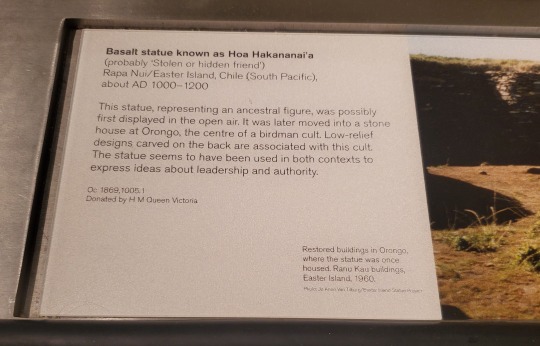
I went to the British Museum today, only because it's free, and I was actually shocked at the Easter Island display. For those who don't know, the Rapa Nui are asking the British museum to return Hoa Hakananai'a, but the museum refuses. The museum is displaying it in the middle of the entrance of the "Living and Dying" exhibit. There are no other artifacts nearby from the Rapa Nui (except the ones in front that aren't identified as far as I could tell) and the card above is literally all of the information given. The statue is really obviously being used as an eye catcher and photo op, not as an opportunity to educate people about the culture that made it.
21 notes
·
View notes
Link
Prominent among the eclectic hoard of treasures in London's British Museum is the imposing figure of Hoa Hakananai'a, a four-tonne basalt statue from the Chilean Pacific territory of Rapa Nui - named Easter Island by European explorers.
The statues, known as moai, were carved by the island's indigenous Rapa Nui people to embody the spirit of a prominent ancestor, with each considered to be the person's living incarnation.
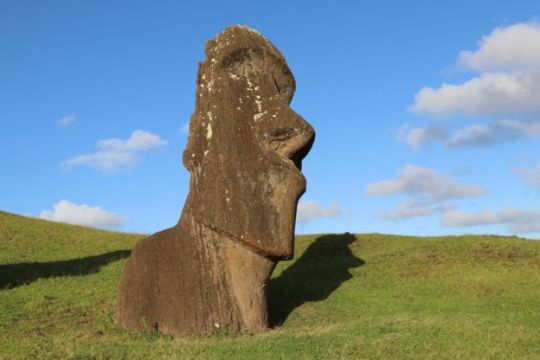
The moai are one of the main attractions for visitors but to locals they have spiritual significance
"The British taking the moai from our island is like me going into your house and taking your grandfather to display in my living room," says Anakena Manutomatoma, who is a native of the island and serves on Rapa Nui's development commission.
"For us, the repatriation of Hoa Hakananai'a is an absolute priority."
Long way from home
The statue, along with a second, smaller moai known as Hava, were given as gifts to Queen Victoria in 1869 by the captain of HMS Topaze, Commodore Richard Powell.
His crew excavated Hoa Hakananai'a from a cliff top near the Rano Kau crater in November 1868, and the Queen donated the two statues to the British Museum.
It has been on display 8,500 miles (13,700km) from its spiritual home ever since.
Alongside its clear cultural and spiritual importance, Hoa Hakananai'a is a particularly fine example of the statues that see thousands of tourists visit Rapa Nui each year.
"In some ways the statue is unique because it is made from a very hard basalt lava rock, unlike the majority of statues on Rapa Nui. As such, it is unusually well-preserved and its features are pristine," says archaeologist Mike Pitts, who spent several nights at the museum in 2012 conducting a detailed scan of Hoa Hakananai'a.
"It also has a unique collection of petroglyphs on its back that almost certainly were not part of the original statue, so you have a second layer of history embodied in the stone."
Calls for repatriation
There has been a recent awakening on the island with regard to repatriating the moai, which under Chilean law are considered to be part of the land.
Sculptor Benedicto Tuki, a Rapa Nui native who has dedicated his life to promoting and preserving the island's indigenous culture, attributes the newfound interest in bringing the moai home to a generational shift.

Benedicto Tuki has devoted his life to preserving the island's indigenous culture
"Perhaps in the past we did not attach so much importance to Hoa Hakananai'a and his brothers, but nowadays people on the island are starting to realise just how much of our heritage there is around the world and starting to ask why our ancestors are in foreign museums."
In order to facilitate the return of the Hoa Hakananai'a, a name often translated as "lost" or "stolen friend", Tuki has offered to make an exact replica to take the statue's place in the British Museum, free of charge.
"Perhaps it won't possess the same ancestral spirit, but it will look identical," the sculptor says. "My only wish is for him to return home; for me this is worth far more than any amount of money. As long as I live, I will fight to see our ancestors returned to the island."
Asking to be heard
Tuki made the offer after the mayor of Rapa Nui, Pedro Edmunds, sent a letter to the British Museum in August requesting the return of the two statues.

There is also a moai outside the archaeology museum of the Chilean city of Viña del Mar
In response, the museum invited a delegation from Rapa Nui to visit the moai and discuss the request.
A group including Ms Manutomatoma will arrive in London on 19 November to propose to the museum's directorate to have Hoa Hakananai'a returned to the island in exchange for Tuki's replica.
Chile's Minister for National Property Felipe Ward, who is leading the delegation, says he is optimistic. "The strong understanding and mutual respect between Chile and the UK can help in this instance."

Anakena Manutomatoma (first from left) and Felipe Ward (third from right) will form part of the delegation
"We are not demanding anything as yet, just asking to be heard. We believe that when this happens, the museum and its authorities will understand the importance of the moai as the soul of the island," he says.
For Tuki, bringing Hoa Hakananai'a back to Rapa Nui is just a first step. Eventually, he would like to see all moai which were removed from the island returned, starting with those that are currently on the Chilean mainland.
"In order for Chile to show that it is serious about supporting our cause, we need to have the moai on the Chilean mainland returned to the island," he says.
Talks are currently under way to return a moai from the Chilean city of La Serena but there are also moai in Viña del Mar and also as far afield as the US, New Zealand, France and Belgium.
Anakena Manutomatoma says that while she, too, dreams of bringing all of her ancestors home to Rapa Nui, her gaze is firmly on Hoa Hakananai'a.
"We have mourned him for too long. It is time to stop crying and take action to bring him home."
#archaeology#arqueologia#rapa nui#easter island#moai#moai statues#chile#ecuador#art#arte#history#historia#british museum#england#united kingdom#uk
340 notes
·
View notes
Text
June 8, 2019 - Rapa Nui, Day Two
We meant to wake up early on our first full day in Rapa Nui, but we didn’t quite manage that. It felt absolutely lovely to sleep in for the first time in a while. We made oatmeal with peanut butter and nutella for breakfast with chamomile tea and honey, and we ate on the terrace while watching the ocean. The morning could not have been more perfect.
We then set off for our hike to the crater of the Rano Kau Volcano, the tallest volcano on the island. The hike was absolutely stunning, and we couldn’t stop turning around to look at the panoramic views of the town and coast that we climbed away from. Along the way, we befriended a man from Mexico who was also exploring the island and a stray dog who had adopted him on the hike up.

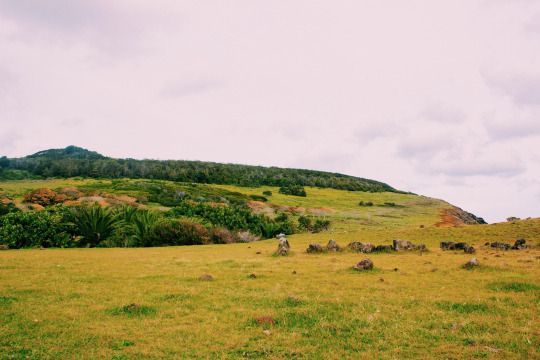





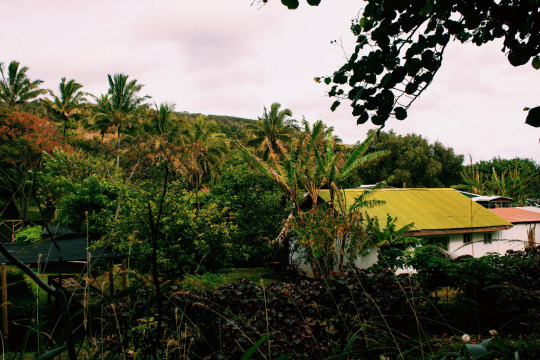


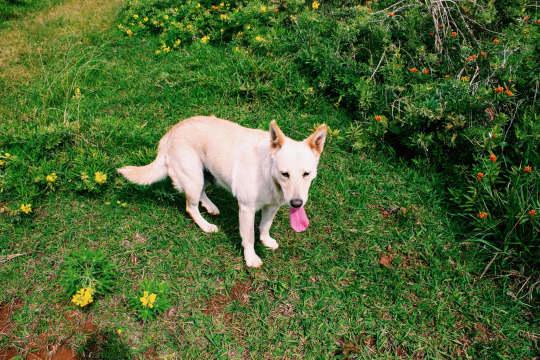




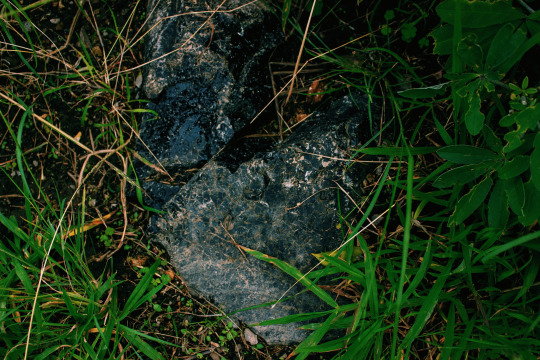


When we reached the top of the trail, dripping in sweat, we found that the hike was 100% worth it. We looked down over a huge volcanic crater filled with water and plant life, and there was a sign that told us this spot was a microclimate of all of Rapa Nui’s biodiversity. We sat and ate granola bars on the edge of the volcano, appreciating the crazy beauty that we had at our feet. You could see the whole island from where we were – every single coast.
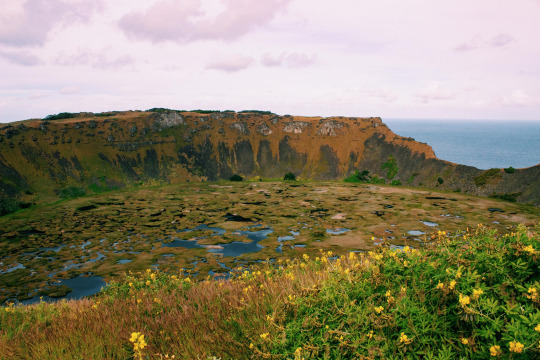
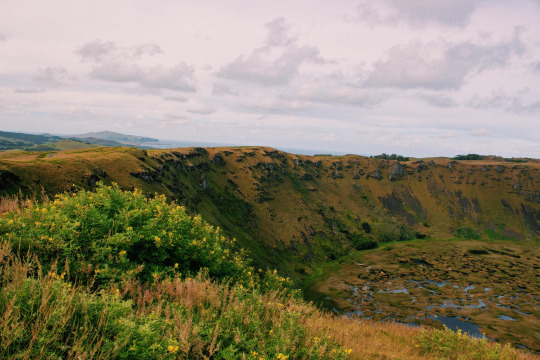
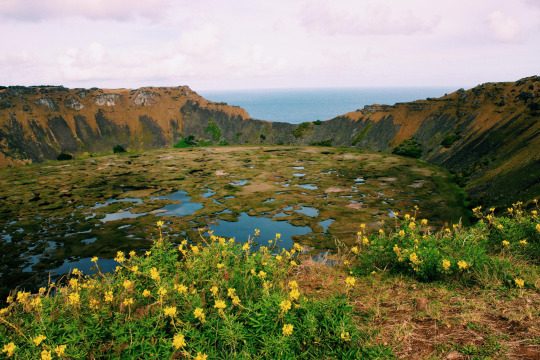


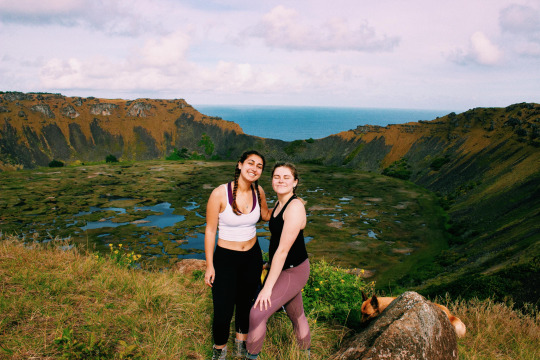







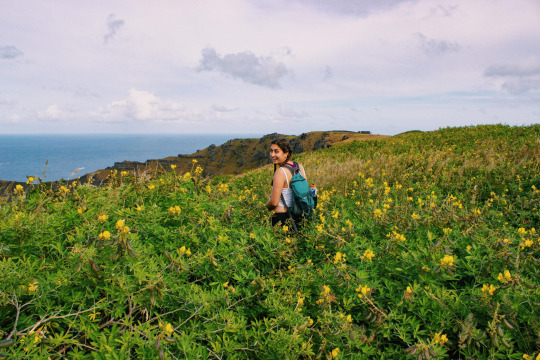

We then walked around the crater to a place called Orongo, the ruins of a Rapa Nui ceremonial village. This village was quite literally sitting on the edge of the crater, wedged between its cliffs and the cliffs that fell into the ocean. We spent a lot of time here, reading about the people who lived here, why they did so, and what their ceremonial practices were. My most important takeaway from this was the emphasis the Rapa Nui people put on the movement of birds, and that the birds’ migratory movements determined the spiritual power of this place. We also learned about the different eras of Rapa Nui culture, and got to see some very cool petroglyphs. It felt so cool to be in a place and learn about it as we were there: we made jokes about how our study abroad program always calls us “active learners,” but that is truly what all of our adventures have been. Lisi is turning me into an anthropology buff the more time we spend together, I swear.

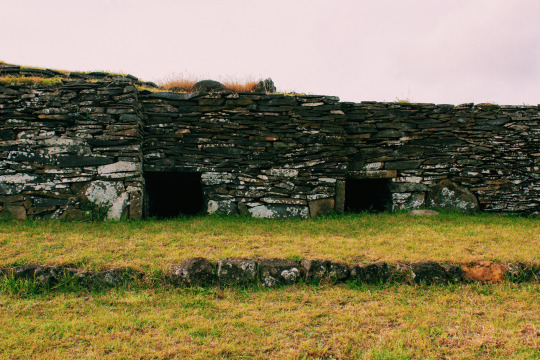




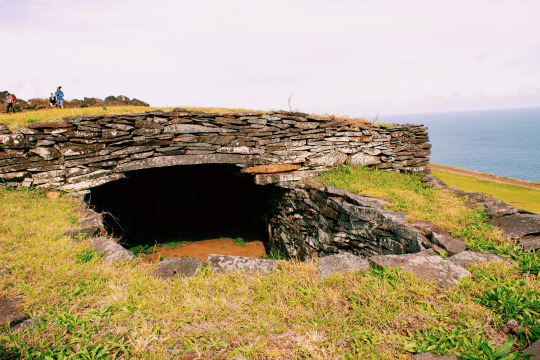

We then decided we did not want to hike all the way back down the volcano, so we asked a woman exploring Orongo with us if she had space in her car for us to hitch a ride back to Hanga Roa, the city center of Rapa Nui. They very sweetly said yes, and we piled into the back of their rental car. This group of women, young and old, were Chileans in the middle of a girls’ trip to Rapa Nui. They were absolutely hysterical, commenting on how attractive the park rangers were (which they were) and yelling out to young men they drove by. They asked us about where we were from, and when we said we were doing an exchange in Chile they instantly asked us if we had a Chilean “pololo” (boyfriend.) Neither Lisi nor I do, and when we said so they all erupted into exclamations of “Necesitas probar un chileno!!” (You need to try a Chilean!!) and “Que ocurre en Chile queda en Chile!” (what happens in Chile stays in Chile.) Lisi and I were dying laughing, and we were all having a wonderful time as they dropped us off at our destination, Tahai. They said goodbye with kisses and hugs, making us promise them that we would kiss a few Chileans before we flew back to the US. This made my heart so full.
After parting with the Chilean ladies, we explored Tahai, a stunning “ahu,” or ceremonial alter, with Moai overlooking the coast. Light was starting to fade as we approached golden hour and sunset, so we snapped a few pictures and then looked for a place to snack before we camped out for the sky’s show. We looked just behind Tahai closer to the city, and there was a sign next to a lawn that said “soda y empanadas de atún.” We walked up, and the area looked somewhat empty, but there was a lovely swing so we sat down and looked out at the sea. After only a minute or two, a woman came up to us and asked us if she could get us anything! We didn’t realize it, but the “restaurant” we had walked into was hers, and we sat on the lawn drinking Diet Coke as we waited for the tuna empanadas we ordered. The location couldn’t have been more perfect – sitting on a lawn looking over Tahai, with chickens flocking around us and horses tethered behind us. Not only was the atmosphere better than the fancy tourist trap next door, but the empanadas were incredible. The grilled ahi tuna inside was delicious, surrounded by cheese and the flaky empanada dough. The perfect snack for watching the beginning of the sunset! We also later realized that this was a restaurant Kapua had recommended to us but we just accidentally stumbled upon.









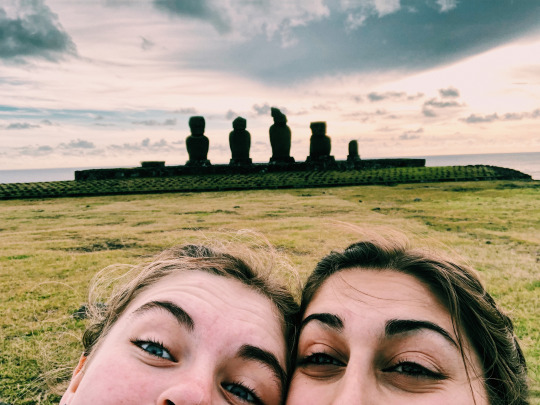
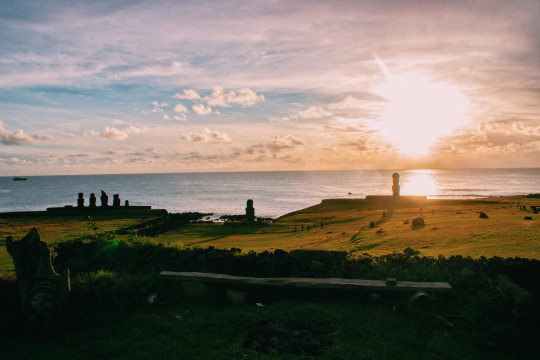
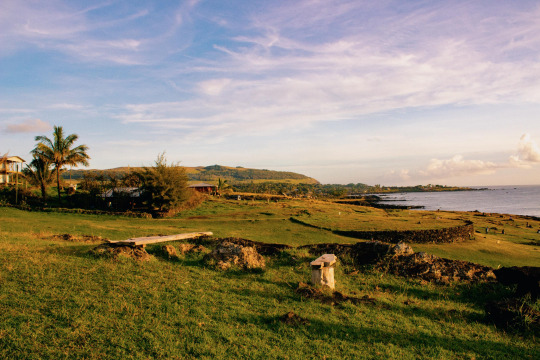
Once golden hour started to turn into sunset, we made our way down to the open grass area to join a number of other people watching the sun set behind the moai of Tahai. I set up my phone for a time lapse and then sat back with my camera to get some shots of the pinks and purples that we knew would come. I could not believe the sunset that came: everything was tinted pink and it felt as though the sky was dancing. I fell in love with the silhouettes of the moai, and There could not have been anything sweeter to watch. However, it got even sweeter. All of a sudden, a large pack of stray dogs descended upon the crowd and just came to cuddle. They played in front of the moai (almost knocking over my time lapse, but just barely missing it) and one in particular decided to be friends with Lisi and I. He flopped onto its back in front of us and required that we scratch his belly. Whenever we paused, he would flip and flop around until we stopped again. A very spoiled stray dog. We sat with him until the sun went down, and then we headed back to Zalo’s house to sleep.
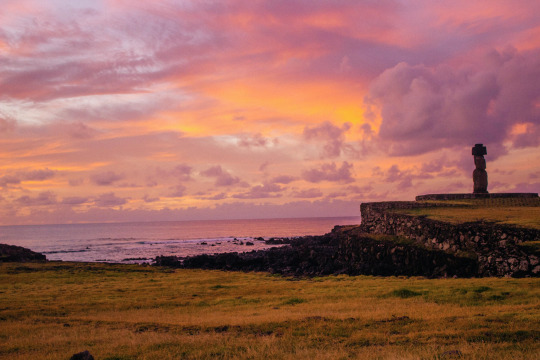
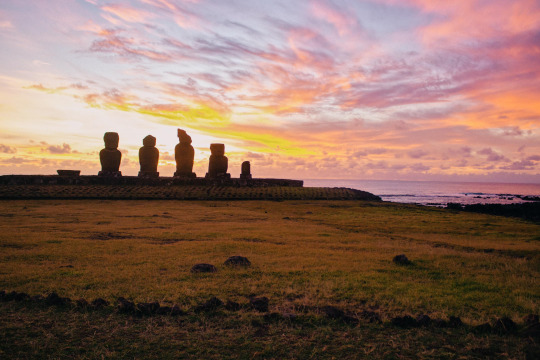

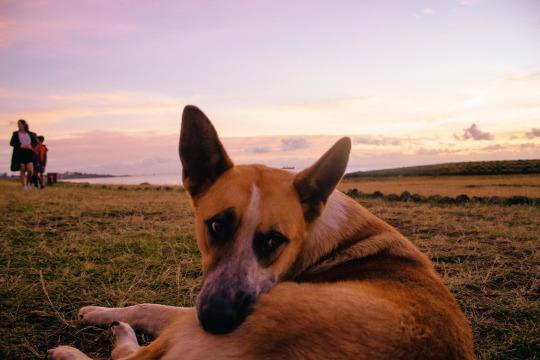


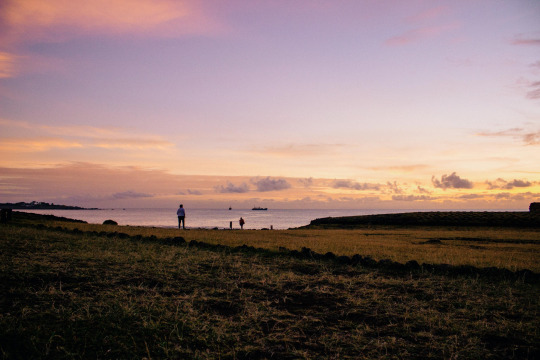



When we arrived home, we were greeted on the front porch by Zalo, Priscilla, Kapua, Zalo’s brother, and Zalo’s mother. They instantly asked us to sit and “compartir” (share) with them, so we sat down. We were welcomed so warmly by everyone in that family. Zalo’s mother, who was clearly meant to be a teacher, instantly turned to Lisi and I and began telling her story of Rapa Nui and the way that their culture has developed. We learned so much from her in a very short conversation about the loss of Rapa Nui traditional writings and the way that the whole island has become mestizo rather than pure native. Without even asking, Priscilla handed us fajitas that she had made (delicious ones.) They invited us to the local “curanto,” (a community picnic with free food and celebration) that was being held the next day, and we rearranged our plans to attend. We all sat and talked for a few hours, and I felt so deeply complete. They not only welcomed us into their home, but into their family and their culture, and it felt as though we had people to come home to each night. We gave goodnight kisses and went up to bed to rest early before the next day of adventures.
1 note
·
View note
Photo

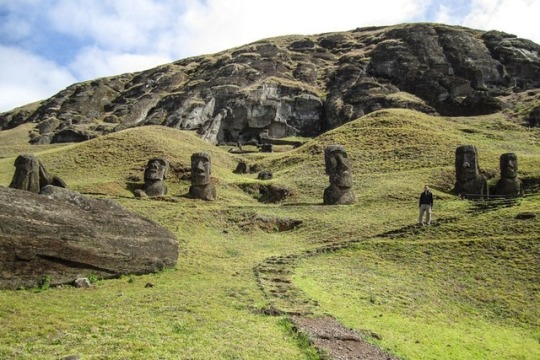
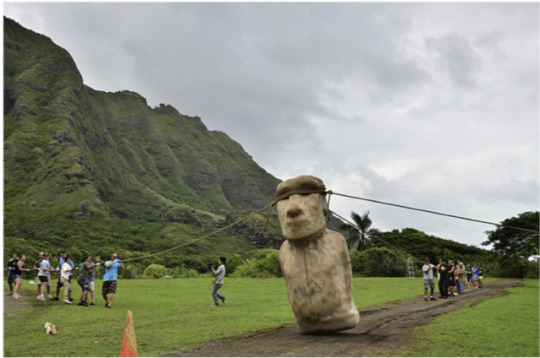
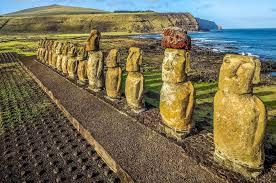
What Are The Moai?
The Moai of Easter island are gigantic stone statues that were carved out of solidified volcanic ash by the Rapa Nui people. The statues were incredibly tall and heavy, with some statues standing nearly forty feet tall and weighing more than 75 tons. The statues were carved in Rano Raraku, the island quarry, and were somehow transported across the island. While statues can be seen scattered among the island, more statues can be seen perched on platforms called ahu. These platforms overlook the island’s coastline, with the statues facing inward rather than looking out at sea. Their location along the perimeter of the island and their inward facing direction suggests that they were of a religious nature, watching over the Rapa Nui people. 950 moai have been counted on the island, with over 500 of these heavy statues seen considerable distances from the quarry.
An unanswered question behind the moai statues is how they were moved. There is not a single witness or documentation of the transportation process of these giant monuments. Oral traditions tell that the statues walked, but give no explanation as to how they walked. Thompson (1889) was told that the statues were “endowed with power to walk about in the darkness” and Metraux (1984) describes that “the huge blocks walked for a distance and then stopped”. Routledge (1919) first discovered roads leading from the quarry and spreading out all over the island. These roads are suggested as the designated pathways used to transport the Moai. Several statues have been found on and along the roadsides that are directly connected to the quarry, suggesting that transportation failed and they were abandoned. Evidence supporting this theory is that the roadside statues lack the platforms (ahu) that are seen with the coastline statues. Secondly, roadside statues lacked the carved eye sockets that were characteristic to the coastline statues perched on the ahu. Although we lack any evidence or documentation on the transport of the moai, it has been theorized that ropes were used to “walk” the statues in an upright fashion along the pathways.
Hunt, Terry, and Carl Lipo
2011 Unraveling the Mystery of Easter Island: The Statues That Walked . Free Press, New York, NY
Lipo, Carl P, Terry L Hunt, and Sergio Rapa Haoa
2013 The Walking Megalithic Statues (Moai) of Easter Island. Journal of Archaeological Science40(6): 2859–2866
2 notes
·
View notes
Text
Things I’ve Expirenced Being an Indigenous Person in the United States [Please feel free to add more, even if you’re not American]
1. Are you sure you’re not [incert race], you look [insert race]
Yes, random drunk tourist, I am sure. I am Polynesian.
2. You’re Polynesian? What’s that?
Polynesia is a geographic location in the Pacifc ocean that encompasses thousands of islands. Some notable islands are Sāmoa, Tonga, Hawai’i [my home], and New Zealand [Aotearoa], and Easter Island [Rapa Nui]. The people from this region are called Polynesians.
3. I thought you guys were all fat and alcoholics.
This is stereotypical and plane offensive. Have some decentsy. The stereotype of the obese and alcoholic Polynesian dates back to white settlers using anything to claim the land we had been on for generations. As for alcoholism, that was started by colonialism and low socio-economic status that many of us face.
4. You’re pretty…for an Islander
I’m pretty in general.
5. You ungreatful brat, you don’t celebrate Thanksgiving
You shouldn’t need a day in the year to be Thankful. I’m thankful for my family and I’m thankful for the fact that I’ll always be able to count on them. But I won’t celebrate a genocide.
6. You’re a Hula Dancer, so you just sway your hips.
The Hula Dance represents our connection with nature. There are many stories about how it originated, but the most accepted one is that the Goddess Laka created the dance on the Island of Moloka’i. Another story is that the Hi’iaka danced this to appease her sister Pele, the Goddess of Fire and Volcanos.
But Hula is a lot more than just swaying your hips. A dancer must go through years of rigorous training. I once tripped over another girl during a rehearsal because I wasn’t paying attention to what I was doing.
Thanks for reading and coming to my tedtalk.
11 notes
·
View notes
Text
Argentina - land of wine, of meat and of tango.
ARGENTINA - Land of wine, of meat, of tango
Day 1. (15/11). It took us half a day to cross the border between Chile and Argentina. Crossed the border and it was pretty fast. I then got into the bus terminal at Calafate, which I will warn you is a bit of a walk away from the city centre (about a 30 min walk). What you have to do to cross the terminal to the taxi side, cross the car park and stay on the road on your left all the way. You will cross a crossroads twice and eventually go downhill and arrive at a T junction. There you turn right and follow the road, cross a canal bridge and you will pretty much be on the Main Street. I would say the walk is safe during the day and fairy easy as its all downhill towars town. The hostal I stayed at was three parallel roads from the Main Street. Try and stay around there. At the hostal book a bus to Perito Moreno (800arg bus ride only; the entrance ticket price is not included) with Caltur. Try to book the day before as in that case the company picks you up at the hostal unlike if you book on the day where you will have to show up at the bus terminal. I then headed out to the market which is on the main road but further out and headed to a butchery before the market on the same road called El Turco.The meat there is of great quality and cheaper than in the market. I advise you get the Bife de Chorizo cut.
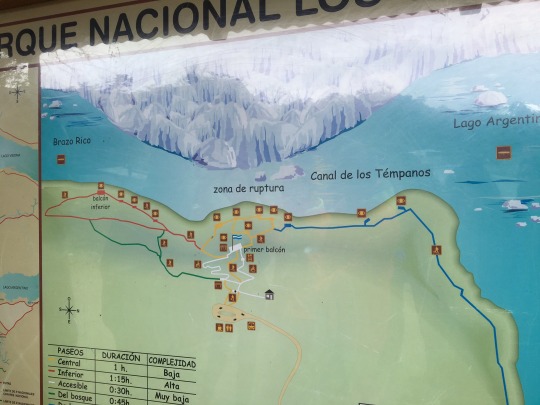
Perito Moreno route options, you can do the whole thing in couple of hours
Day 2. (16.11). We were picked up around 8am ish and it took us 1.5hrs to get to Perito Moreno. You are dropped off at the car park but before you stop to pay the entrance to the park which you can pay by card or cash. Cash is faster. Once you get there you walk around in these platforms. There area few routes: black, blue, yellow and green. We did the blue, yellow then red. The green is through the forest so you can't see the glacier so we skipped it. The bus picks you up at 15:45. We took food into the walk so you can eat and enjoy the scenery on the benches dotted around. We were back for 5pm. Then I bought tickets for a day in Chalten (1,600 and 3hr drive). If I had more time I would have stayed around 3 days to a week in Chalten.

Perito Moreno
Day 3. (17/11). The bus to Chalten got there at 11am and got to the start of the Fitz Roy trek for 11:30am. Be warned that with only one day there (arriving at 11am and leaving at 6pm you can either do the loop that I did and see a bit of each trek or commit to a full trek). From 11:30am-1:10pm I managed to do the first third of the trek where I stopped to look at Fitz Roy for 10 minutes. At the cross section at the top for the second third of the tweak where I went left down towards Laguna Madre y Hija, I arrived at the bottom at 2:20pm. The way was mainly downhill. By 3:30pm I was on the end of the walk/sendero and got to Chalten town in another 10 minutes and before 4pm I was back at the bus station. This meant that I had to wait around 1.5hrs for the bus. This trek was estimated at 6hrs but I did it in 4hrs at a fast pace. As it was mainly downhill allowed for a quicker pace. I estimated 1.5 hours for each third of the trek. I would advise you did the same to give yourself enough time. Below is a picture of the route map...

The actual walk is super beautiful...

Fitz Roy, Chalten
Day 4. (18.11). On this day I woke up and took a transfer to the airport which I booked at the hostal. I paid the driver after the ride. Bag drop off in 19 mins so no need to arrive too early. The flight took 2.5hrs. As I landed I connected to the airport Wi-fi and ordered an Uber. Be warned that the Ubers cannot come into the pick up area of the airport so keep an eye out on the street for your Uber. As I arrived at the end of the afternoon at Benita Hostal I bought some food at the nearby shops, a nice bottle of wine and had a chilled evening. When booking your hostal look to stay in Palermo area. It’s safe and close to a lot of stuff.

Floralis at the United Nations Plaza
Day 5. (19.11) I headed out early to see the street art in Calle Serrano. Then in the pm I headed to Buenos Aires' Recoleta area. First I saw the the Floralis at the United Nations Plaza that works with solar energy and it opens and closes depending on the time of the day. It’s a very slow movement so you won't really see it happening. Followed by the Facultad de Derecho and the Centro Cultural and an exhibition on film and Freud. We saw also some music open air on the green near the bellas artes museum and cultural centre and walked around the market stalls. Then back and to Rapa Nui for ice cream. Yum.
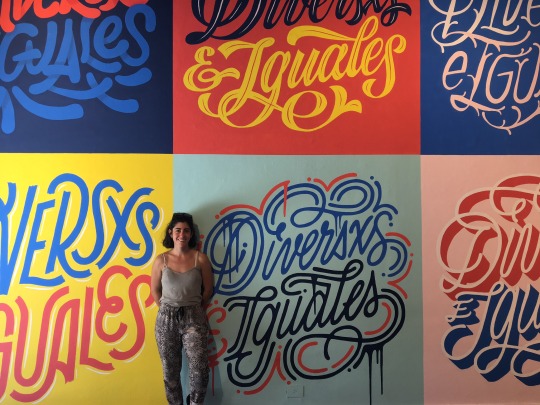
Centro Cultural, Recoletta, Buenos Aires
Day 6. (20.11). Visiting Buenos Aires city center highlights. La Liberia El Atendo Grand Splendid formerly a theatre; Palacio de Aguas Corrientes; the National Congress of Argentina; Casa Rosada former presidential house built in 1873; Puente de La Mujer designed to look like tango dancers; Plaza Dorrego in Monserrat and the San Telmo market up to the Kavanagh building being the tallest in Argentina in its time and lastly the Colon theatre and the Obelisk. From where I was based made sense. A bit of a zigzag but it worked. About 7 hours walk.

The Kavanagh building
Day 7. (21.11). Woke up went to get a subte card which costs 65 arg plus 35 arg charge. You can either get one by an underground station or, as in my case, right in front of the hostal there was a shop that sold it; just ask at reception. I then headed back to the corner of my hostel and got the 29 bus towards Boca (make sure it says Boca at the front as there are two 29s). Around 45 mins later I was getting off at Caminitos. Just keep an eye on mapsme or your offline Google to know when to get off or ask the driver. Caminitos is a small street and the Boca stadium in only a 2 min walk north. Maybe consider a tour which will last you around 3 hours I reckon. Just walk around and enjoy some free tango, lots of souvenir shops and awesome picture spots. From there we walked north to San Telmo for a photo with Matilda on her bench at Chile with Defensa street. From there to the CCK (a cultural centre by the Casa Rosada) then back home on the green tube line for an easy night.
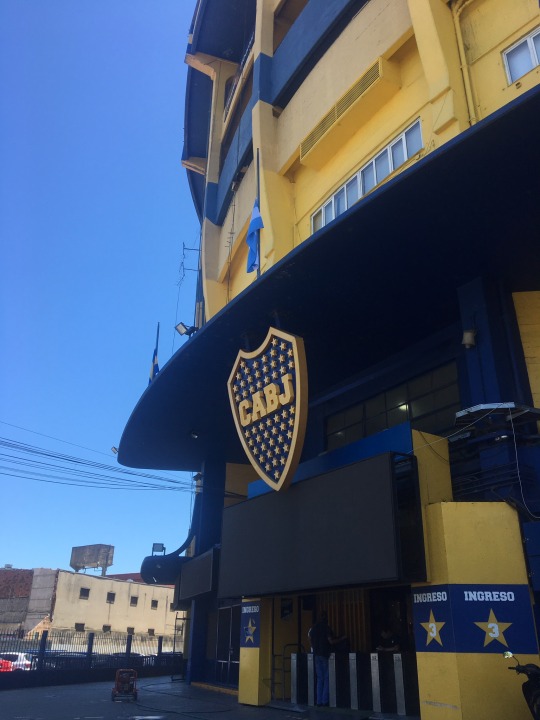
BOCA stadium
Day 8. (22.11). Woke up and the weather wasn't too great but headed north past Bulnes to do a park route. Past the Las Heras Park then to the Botanical Park. Then north past eco Park and then across to the Paseo El Rosedal - this stunning rose park! Then back towards the planetarium, past the Japanese garden and then the floralis cultural centre and back. Short pit stop at the Buffala Heladeria - yum! Spent most afternoon chilling and packing as wel as buying last minute things.
Day 9. (23.11). Wake up at 6:30am and left the hostal at 8am and made it to the airport for 8:30am. I checked in and dropped bags off. The duty free section of the AEP airport is tiny and no Havana inside so buy outside or better yet in the city as it's cheaper. Flight on time, 2.5 hours I was in Brasil.
—————————
ARGENTINA CRIBSHEET
Hostals:
Calafate: Hostel Cambalache (its clean and the guys there super attentive, not the biggest but I liked it. You also get a discount on the restaurant next door).
Buenos Aires: Benita Hostal (or anywhere in Palermo really)
Restaurants:
Ice cream: Rapa Nui; Buffala Heladeria
Cafeterias: Cafe Tortoni; Florida Garden Cafe.
Things to do:
Calafate: Perito Moreno
Chalten: various walks
Buenos Aires: Recolletta area; Palermo; Liberia El Atendo Grand Splendid formerly a theatre; Palacio de Aguas Corrientes; the National Congress of Argentina; Casa Rosada former presidential house built in 1873; Puente de La Mujer designed to look like tango dancers; Plaza Dorrego in Monserrat and the San Telmo market (and Matilda bench); Kavanagh building; Caminitos/ BOCA stadium.
—————————
#argentina#calafate#chalten#buenosaires#travel#travelling#thingstodo#thingstosee#food#journey#visionworld#yourworld#myworld#ourworld
1 note
·
View note
Note
morning paper anon again (i think im just gonna call myself MPA for now)
what do you know about visas and travel documents around the world? i would like to hear it
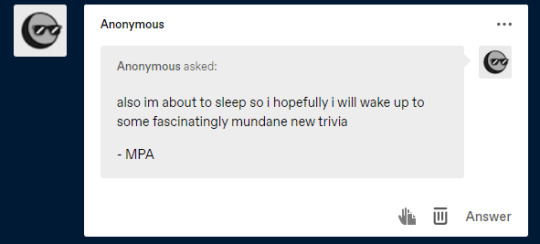
god are you sure you wanna go down this rabbit hole?
I could say so many things but did you know that a Japan or Singapore passport allows you to enter to 192 without a visa? US passport holders can visit 185 countries visa-free. Afghanistan passport holders? only 26
Did you know that Lebanon denies entrance to anyone with an Israeli stamp in their passport? So if you wanna travel to every country in the world, you have to visit Israel first. Yeah it doesn't matter if you're not an 'Israel' citizen (you can work around this with a new passport, I've been told, but like. I find it amusing. Anyway we don't respect Israel in this blog)
Anywayssss, did you know that while Rapa Nui is considered part of Chile, it is legally considered 'travelling abroad' even for Chileans who live in the continent? Yeah, even if you are Chilean, you get a 'you're leaving Chile' stamp when you go through customs and a 'welcome to chile' stamp when you go through customs in Mataveri International Airport.
Wanna talk about visas? Did you know South Korea has Working Holiday agreements with 13 countries? They also allow visa-free entry to 110 countries. They have an obscene amount of bilateral agreements that make it super easy to visit.
In contrast, North Korea only allows visa-free entry to Diplomatic Passport Holders of only 20 countries. And that's a very exclusive passport that only people who are travelling abroad performing gvmnt mandated duties in the country they're visiting. Anyone else? They need to go through a rigurous process that can take up to 6 months depending on where you're from.
yeah i'll shut up now before I get into how that process works
#i have been cursed with tons of useless information#also i know a hell of a lot about fandom history#as in i was a regular fanlore contributor for a few years#I've done academic levels of research into fandom. i could write a fucking thesis about fandom history#this is my show don't tell for mental illnesses lmao#morning paper anon#thank u for talking to me and reading my tags#kissing u tenderly on the forehead#like that succession dude#anon#replies
0 notes
Photo

Makemake, Pamela Rys
video: : https://youtu.be/8o1PRu7n8Vc This is abstract painting on high quality linen and custom made canvas. I'm currently creating a new series of paintings about Trans-Neptunian object. I'm inspired by structure of celestial bodies. This one was inspired by surface of Makemake. is a dwarf planet and perhaps the largest Kuiper belt object in the classical population, with a diameter approximately two thirds that of Pluto. It was discovered on March 31, 2005, by a team led by Michael E. Brown. Makemake's extremely low average temperature, about 30 K (−243.2 °C). Its name derives from Makemake in the mythology of the Rapa Nui people of Easter Island. I very much enjoyed painting process, because it gave me a lot of room to experiment. I also discovered some new features of materials that I used. It is mixed-media painting in heavy impasto with iridescent acrylic paints, gesso, plastic, sand and shingles. I use only top quality art materials. Finest quality high grade professional acrylic paints and gallery quality canvas. Finished with a glaze of UV varnish to protect against sunlight and dust damage. The colors may look a little bit different depending on the screen. An artwork is signed on the back. Original title is written on the back. A signed Certificate Of Authenticity will be included with the artwork. Size: 120 H 100 W x 4 cm 47.2" x 35.9" x 1.6" This original artwork is currently for sale. __________________________________________________ FRAMED: The artwork is ready to hang. The painting don't need frame, it is painted on the edges. Please note, painting is being sold unframed. Framed picture is only for your reference. The images in context are not to scale and are for display purposes only. __________________________________________________ SHIPPING: In order to protect your painting I will pack it with great care using quality shipping packing materials designed for art safe delivery. It will be packaged in a cardboard box with bubble support for safety. Labeled: Fragile. All artworks are shipped within 1-5 business days. Worldwide shipping takes around 10 days to arrive, depending on it's destination. Each painting is inspected and professionally packaged for safe travel so that your artwork arrives to you in perfect condition. All works are insured for the whole evaluated price. Please feel free to contact me if you would like to ask any questions. __________________________________________________ © Pamela Rys, pamelarys.com
https://www.saatchiart.com/art/Painting-Makemake/728512/4411686/view
0 notes